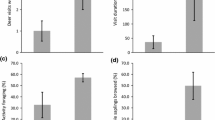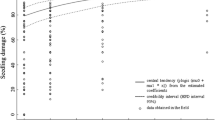Abstract
Ungulates impact woody species’ growth and abundance but little is understood about the comparative impacts of different ungulate species on forest expansion in savanna environments. Replacement of native herbivore guilds with livestock [i.e., beef cattle (Bos taurus)] has been hypothesized as a factor facilitating trembling aspen (Populus tremuloides Michx.) encroachment into grasslands of the Northern Great Plains. We used a controlled herbivory study in the Parklands of western Canada to compare the impact of native ungulates and cattle on aspen saplings. Native ungulate treatments included a mixed species guild and sequences of herbivory by different ungulates [bison (Bison bison subsp. bison), elk (Cervus elaphus) then deer (Odocoileus hemionus); or deer, elk, then bison]. Herbivory treatments were replicated in three pastures, within which sets of 40 marked aspen saplings (<1.8 m) were tracked along permanent transects at 2-week intervals, and compared to a non-grazed aspen stand. Stems were assessed for mortality and incremental damage (herbivory, leader breakage, stem abrasion and trampling). Final mortality was greater with exposure to any type of herbivore, but remained similar between ungulate treatments. However, among all treatments, the growth of aspen was highest with exposure only to cattle. Herbivory of aspen was attributed primarily to elk within the native ungulate treatments, with other forms of physical damage, and ultimately sapling mortality, associated with exposure to bison. Overall, these results indicate that native ungulates, specifically elk and bison, have more negative impacts on aspen saplings and provide evidence that native and domestic ungulates can have different functional effects on woody plant dynamics in savanna ecosystems.





Similar content being viewed by others
References
Alexander MJ (1995) The response of mature decadent and healthy sapling aspen forest communities to prescribed burning and controlled livestock grazing. M.Sc. thesis, Department of Plant Science, University of Alberta, Edmonton, Alberta
Anderegg WL, Plavcová L, Anderegg LDL, Hacke UG, Berry JA, Field CB (2013) Drought’s legacy: multiyear hydraulic deterioration underlies widespread aspen forest die-off and portends increased future risk. Global Change Biol. doi:10.1111/gcb.12100
Arthur RL (1984) Plant community and forage preferences of cattle on native Aspen Parkland range. M.Sc. thesis, Department of Plant Sciences, University of Alberta, Edmonton, Alberta
Asamoah SA, BorkEW Irving BD, Price MA, Hudson RJ (2003) Cattle herbage utilization patterns under high-density rotational grazing in the Aspen Parkland. Can J Anim Sci 83:541–550
Augustine DJ, McNaughton SJ (1998) Ungulate effects on the functional species composition of plant communities: herbivore selectivity and plant tolerance. J Wildl Manage 62:1165–1183
Bailey AW, Irving BD, Fitzgerald RD (1990) Regeneration of woody species following burning and grazing in the aspen parkland. J Range Manage 43:212–215
Bird RD (1961) Ecology of the Aspen Parkland of western Canada in relation to land use. Publication no. 1006. Research Branch, Canadian Department of Agriculture, Ottawa
Bork EW, Hudson RJ, Bailey AW (1997) Populus forest characterization in Elk Island National Park relative to herbivory, prescribed fire and topography. Can J Bot 75:1518–1526
Campbell ID, Campbell C (2000) Late Holocene vegetation and fire history at the southern boreal forest margin in Alberta, Canada. Palaeogeogr Palaeoclimatol Palaeoecol 164:263–280
Campbell C, Cambell ID, Blyth CB, McAndrews JH (1994) Bison extirpation may have caused aspen expansion in Western Canada. Ecography 17:360–362
Didkowsky MG (2006) Scales of forage selection by ungulates in Aspen Parkland. M.Sc. thesis, Department of Biological Sciences, University of Alberta, Edmonton, Alberta
Dockrill CWM, Blenis PV, Bailey AW, King JR (2004) Effect of summer cattle grazing on aspen stem injury, mortality and growth. For Chron 80:257–261
Dockrill CWM, Bailey AW, Blenis PV, King JR (2006) Seasonal variation in resistance of aspen stems to shearing force. Rangel Ecol Manage 59:212–215
Dublin HT, Sinclair ARE, McGlade J (1990) Elephants and fires as a cause of multiple stable states in the Serengeti-Mara woodlands. J Anim Ecol 59:1147–1164
England RE, DeVos A (1969) Influence of animals on pristine conditions on the Canadian grasslands. J Range Manage 22:87–94
Fitzgerald RD, Bailey AW (1984) Control of aspen regrowth by grazing with cattle. J Range Manage 37:157–158
Fuhlendorf SD, Engle DM (2001) Restoring heterogeneity on rangelands: ecosystem management based on evolutionary grazing patterns. Bioscience 51:626–632
Goheen JR, Keesing F, Allan BF, Ostfeld RS (2004) Net effects of large mammals on Acacia seedling survival in an African savanna. Ecology 85:1555–1561
Goheen JR, Palmer TM, Keesing F, Riginos C, Young TP (2010) Large herbivores facilitate savanna tree establishment via diverse and indirect pathways. J Anim Ecol 79:372–382
Hoffmann RR (1989) Evolutionary steps of ecophysiological adaptation and diversification of ruminants: a comparative view of their digestive system. Oecologia 78:443–457
Hogg EH (1994) Climate and the southern limit of the western Canadian boreal forest. Can J For Res 24:1835–1845
Hogg EH, Brandt JP, Michaellian M (2008) Impacts of a regional drought on the productivity, dieback and biomass of western Canadian aspen forests. Can J For Res 38:1373–1384
Hudson RJ, Frank A (1987) Foraging ecology of bison in aspen boreal habitats. J Range Manage 40:71–75
Johnson BK, Kern JW, Wisdom MJ, Findholt SL, Kie JG (2000) Resource selection and spatial separation of elk and mule deer in spring. J Wildl Manage 64:685–697
Kay CE, Bartos DL (2000) Ungulate herbivory on Utah aspen: assessment of long-term exclosures. J Range Manage 53:145–153
Launchbaugh KL, Howery LD (2005) Understand landscape use patterns of livestock as a consequence of foraging behavior. Rangel Ecol Manage 58:99–108
Maclean JE, Goheen JR, Doak DF, Palmer TM, Young TP (2011) Cryptic herbivores mediate the strength and form of ungulate impacts on a long-lived savanna tree. Ecology 92:1626–1636
McNaughton SJ, Georgiadis NJ (1986) Ecology of African grazing and browsing mammals. Annu Rev Ecol Syst 17:39–65
Milchunas DG, Lauenroth WK (1989) Three-dimensional distribution of plant biomass in relation to grazing and topography in the shortgrass steppe. Oikos 55:82–86
Morgan RG (1980) Bison movement patterns on the Canadian plains: an ecological analysis. Plains Anthropol 25:143–159
Murry MG, Illius AW (2000) Vegetation modification and resource competition in grazing ungulates. Oikos 89:501–508
Nelson JG, England RE (1971) Some comments on the causes and effects of fire in the Northern Grasslands area of Canada and the nearby United States. C.A. 1750–1900. Can Geogr 15:295–306
Odadi WO, Abdulrazak SA, Karachi MM, Young TP (2011) African wild ungulates compete with or facilitate cattle depending on season. Science 333:1573–1755
Painter LE, Ripple WJ (2012) Effects of bison on willow and cottonwood in northern Yellowstone National Park. For Ecol Manage 264:150–158
Peterson EB, Peterson NM (1992) Ecology, management and use of aspen and balsam poplar in the prairie province. Special report no. 1. Forestry Canada, Northern Forestry Center, Environment Canada, Edmonton, Alberta
Plumb GE, Dodd JL (1993) Foraging ecology of bison and cattle on a mixed prairie—implications for natural area management. Ecol Appl 3:631–643
R Core Team (2012) R: a language and environment for statistical computing. R Foundation for Statistical Computing, Vienna
Reynolds HW, Hansen RM, Peden DG (1978) Diets of Slave River lowland bison herd, Northwest Territories Canada. J Wildl Manage 42:581–590
Roe FG (1951) The North American Buffalo: a critical study of the species in its wild state. University of Toronto Press, Toronto
Scheffler EJ (1976) Aspen forest vegetation in a portion of the East Central Alberta Parklands. M.Sc. thesis, Department of Plant Science, University of Alberta, Edmonton, Alberta
Schier GA (1973) Origin and development of aspen root suckers. Can J For Res 3:45–53
Shepperd WD, Bartos DL, Mata SA (2000) Above- and below-ground effects of aspen clonal regeneration and succession to conifers. Can J For Res 31:739–745
Strong WL (1977) Pre- and post-settlement palynology of southern Alberta. Rev Palaeobot Palynol 23:373–387
Vance RE, Emerson D, Habgood T (1983) A mid-Holocene record of vegetative change in central Alberta. Can J Earth Sci 20:364–376
Voetin MM, Prins HHT (1999) Resource partitioning between sympatric wild and domestic herbivores in the Tarangire region of Tanzania. Oecologia 121:287–294
Wheeler GW (1976) Some grassland and shrubland communities in the Parklands of central Alberta. M.Sc. thesis, Department of Plant Science, University of Alberta, Edmonton, Alberta
Worrall JJ, Rehfeldt GE, Hamman A, Hogg EH, Marchetti SB, Michaelian M, Gray LK (2013) Recent declines of Populous tremuloides in North America linked to climate. For Ecol Manage. doi:10.1016/j.foreco.2012.12.033
Acknowledgments
This paper is dedicated to the late Dr R. J. Hudson, lead investigator of this research project, whose vision and leadership in pushing sustainable natural resource management forward in western Canada will never be forgotten. Comments from two anonymous reviewers and Truman Young improved this manuscript. We thank the many field assistants and staff from the University of Alberta who aided in running the grazing trials or collecting data during this study, particularly Barry Irving, Jack Welch, Tyler Welch, Malcolm Coupe, Michael Clark, and Gordon McNickle. Funding for this study was provided by the University of Alberta, and a Natural Sciences and Engineering Research Council strategic grant to R. J. Hudson, E. W. Bork, J. F. Cahill, D. Hik and E. Merrill. The experiments reported on here comply with the current laws of Canada, including meeting all requirements of the Canadian Council on Animal Care.
Author information
Authors and Affiliations
Corresponding author
Additional information
Communicated by Truman Young.
Deceased: R. J. Hudson.
Rights and permissions
About this article
Cite this article
Bork, E.W., Carlyle, C.N., Cahill, J.F. et al. Disentangling herbivore impacts on Populus tremuloides: a comparison of native ungulates and cattle in Canada’s Aspen Parkland. Oecologia 173, 895–904 (2013). https://doi.org/10.1007/s00442-013-2676-x
Received:
Accepted:
Published:
Issue Date:
DOI: https://doi.org/10.1007/s00442-013-2676-x




